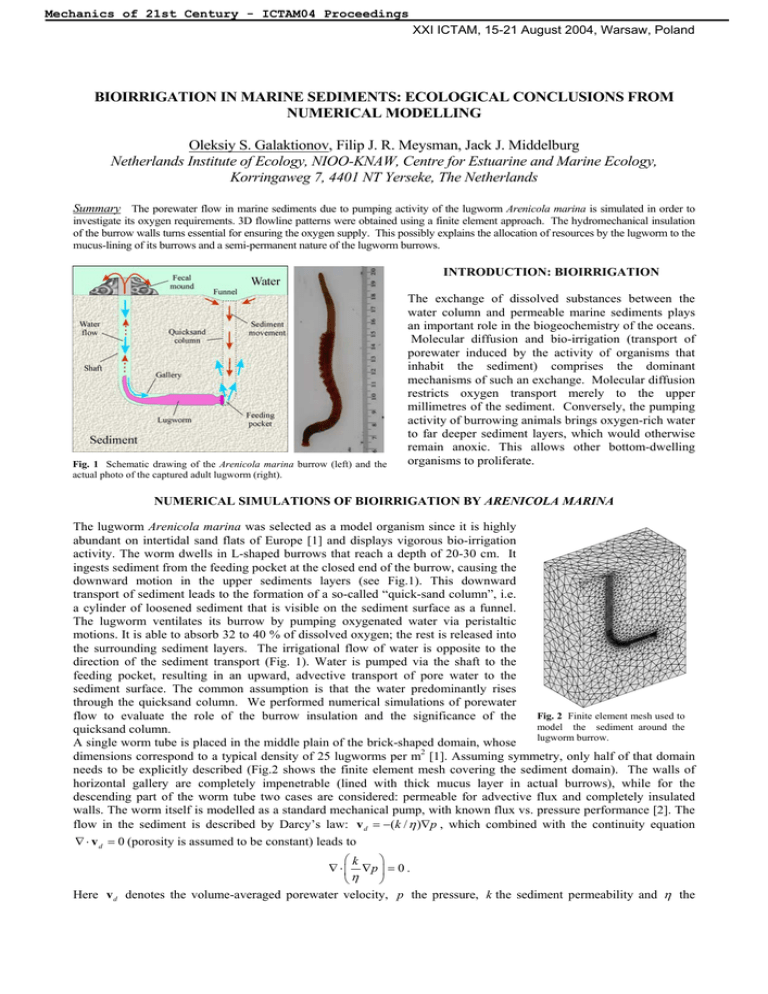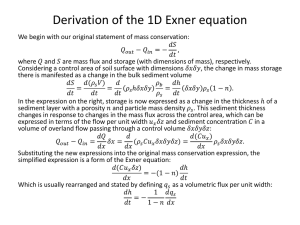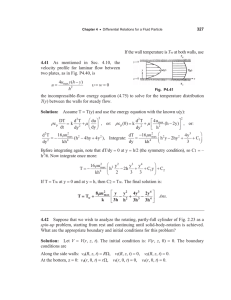Oleksiy S. Galaktionov, Filip J. R. Meysman, Jack J. Middelburg
advertisement

Mechanics of 21st Century - ICTAM04 Proceedings XXI ICTAM, 15-21 August 2004, Warsaw, Poland BIOIRRIGATION IN MARINE SEDIMENTS: ECOLOGICAL CONCLUSIONS FROM NUMERICAL MODELLING Oleksiy S. Galaktionov, Filip J. R. Meysman, Jack J. Middelburg Netherlands Institute of Ecology, NIOO-KNAW, Centre for Estuarine and Marine Ecology, Korringaweg 7, 4401 NT Yerseke, The Netherlands Summary The porewater flow in marine sediments due to pumping activity of the lugworm Arenicola marina is simulated in order to investigate its oxygen requirements. 3D flowline patterns were obtained using a finite element approach. The hydromechanical insulation of the burrow walls turns essential for ensuring the oxygen supply. This possibly explains the allocation of resources by the lugworm to the mucus-lining of its burrows and a semi-permanent nature of the lugworm burrows. INTRODUCTION: BIOIRRIGATION Fig. 1 Schematic drawing of the Arenicola marina burrow (left) and the actual photo of the captured adult lugworm (right). The exchange of dissolved substances between the water column and permeable marine sediments plays an important role in the biogeochemistry of the oceans. Molecular diffusion and bio-irrigation (transport of porewater induced by the activity of organisms that inhabit the sediment) comprises the dominant mechanisms of such an exchange. Molecular diffusion restricts oxygen transport merely to the upper millimetres of the sediment. Conversely, the pumping activity of burrowing animals brings oxygen-rich water to far deeper sediment layers, which would otherwise remain anoxic. This allows other bottom-dwelling organisms to proliferate. NUMERICAL SIMULATIONS OF BIOIRRIGATION BY ARENICOLA MARINA The lugworm Arenicola marina was selected as a model organism since it is highly abundant on intertidal sand flats of Europe [1] and displays vigorous bio-irrigation activity. The worm dwells in L-shaped burrows that reach a depth of 20-30 cm. It ingests sediment from the feeding pocket at the closed end of the burrow, causing the downward motion in the upper sediments layers (see Fig.1). This downward transport of sediment leads to the formation of a so-called “quick-sand column”, i.e. a cylinder of loosened sediment that is visible on the sediment surface as a funnel. The lugworm ventilates its burrow by pumping oxygenated water via peristaltic motions. It is able to absorb 32 to 40 % of dissolved oxygen; the rest is released into the surrounding sediment layers. The irrigational flow of water is opposite to the direction of the sediment transport (Fig. 1). Water is pumped via the shaft to the feeding pocket, resulting in an upward, advective transport of pore water to the sediment surface. The common assumption is that the water predominantly rises through the quicksand column. We performed numerical simulations of porewater Fig. 2 Finite element mesh used to flow to evaluate the role of the burrow insulation and the significance of the model the sediment around the quicksand column. lugworm burrow. A single worm tube is placed in the middle plain of the brick-shaped domain, whose 2 dimensions correspond to a typical density of 25 lugworms per m [1]. Assuming symmetry, only half of that domain needs to be explicitly described (Fig.2 shows the finite element mesh covering the sediment domain). The walls of horizontal gallery are completely impenetrable (lined with thick mucus layer in actual burrows), while for the descending part of the worm tube two cases are considered: permeable for advective flux and completely insulated walls. The worm itself is modelled as a standard mechanical pump, with known flux vs. pressure performance [2]. The flow in the sediment is described by Darcy’s law: v d = −(k / η )∇p , which combined with the continuity equation ∇ ⋅ v d = 0 (porosity is assumed to be constant) leads to ⎛k ⎞ ∇ ⋅ ⎜ ∇p ⎟ = 0 . η ⎝ ⎠ Here v d denotes the volume-averaged porewater velocity, p the pressure, k the sediment permeability and η the Mechanics of 21st Century - ICTAM04 Proceedings XXI ICTAM, 15-21 August 2004, Warsaw, Poland water viscosity. The latter equation is solved numerically using the finite element technique implemented in the Chemical Engineering Module of FEMLAB [3]. To evaluate the importance of the quicksand channel (typical diameter is approx. 5mm) additional simulations were performed. The flow inside an axisymmetric (which allows to use finer grids) cylindrical domain with insulated bottom and side walls and open top is generated by a small source located at the axis of symmetry. The quicksand column, where the permeability linearly increases, reaching 10 times higher value in the center, is running from the source to the top of the cylinder. Fig.3 shows the results of passive tracer advection simulation with and without permeability variation in the quicksand. The tracer concentration profiles differ only slightly: although quicksand channel leads to formation of a “finger” along it, the spreading of tracer in other directions is barely affected. This justifies the use of the assumption of uniform sediment properties for computations in the domain depicted in Fig.2. In the case of the completely insulated burrow walls the water injected into the Fig. 3 Passive tracer profile in the uniform sediment rises to the surface over a whole domain mildly affected by the sediment and in the presence of quicksand. presence of insulated worm tube. However, when the shaft walls are permeable, a significant amount of water pumped by the worm (close to 40 % in the burrow configuration depicted in Fig.2) re-enters the burrow through these permeable walls. The porewater, re-entering the burrow will be already anoxic, all the remaining oxygen already consumed by the benthic bacterial community. Since the sole reason for the pumping activity of the lugworm is to insure the oxygen supply for own respiration, such flow shortcuts should have a strong adverse effect. The losses of the average lugworm’s peristaltic pump performance due to flow short-circuits are illustrated in Fig.4. The lower curve corresponds to the amount of oxygen (oxygenated water from the overlying water column) actually delivered in the case of completely permeable shaft walls as compared to the total pumped flux. The sediment permeability limits the maximum achievable pumping rate and determines the “working point” of the lugworm’s pump at the performance diagram (Fig.4). To ensure the animal survival the minimum oxygen demands should be met. Thus, insulating the burrow walls helps to extend the habitat range of the lugworms towards less permeable muddy sediments. Wall insulation may be created not only actively by lining with mucus layer but also indirectly due to accumulation of iron oxides around the burrow as a result of oxygen diffusion through the walls. The burrow shafts are typically surrounded by brownish halo of iron oxides additionally reducing the permeability of the walls. We may speculate that the additional benefit of these slowly developing type of insulation constitute another reason (in additional to Fig. 4 Lugworm pump efficiency (in delivering oxygen) with avoiding predators) of semi-permanent nature of the tubes and and without burrow wall insulation in different sediments. long-time usage of the same shafts. CONCLUDING REMARKS Numerical simulations enable a better understanding of bio-irrigation processes caused by the pumping activity of bottom-dwelling marine animals. In particular a significance of the insulation of burrow walls by different mechanisms is evaluated. Limited influence of quicksand column implies that the oxygenated water is reaching below the burrow depth. Another interesting application of such 3D simulations is the development of simplified 1D models (not covered in this summary) to account for the sea bottom in the large-scale models of reactive transport in the ocean. References [1] [2] [3] << session Beukema, J. J. & de Vlas, J.: Population parameters of the lugworm, Arenicola marina, living on tidal flats in the Dutch Wadden Sea. Neth. J. Sea Res. 13:331-353, 1979. Riisgard, H. U., Bernsten, I. & Tarp, B.: The lugworm (Arenicola marina) pump: characteristics, modelling and energy cost. Mar. Ecol. Prog. Ser. 138:149-156, 1996. COMSOL AB: FEMLAB Chemical Engineering Module. COMSOL AB, Tegnérgatan 23, SE-111 40 Stockholm, Sweden, 2002. << start




